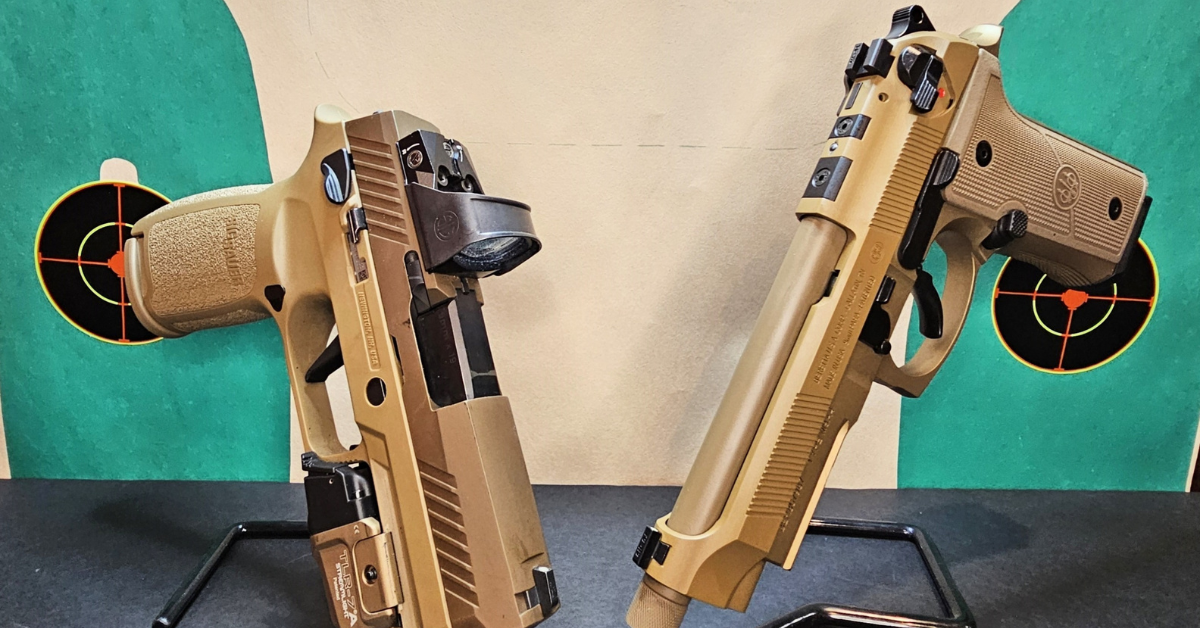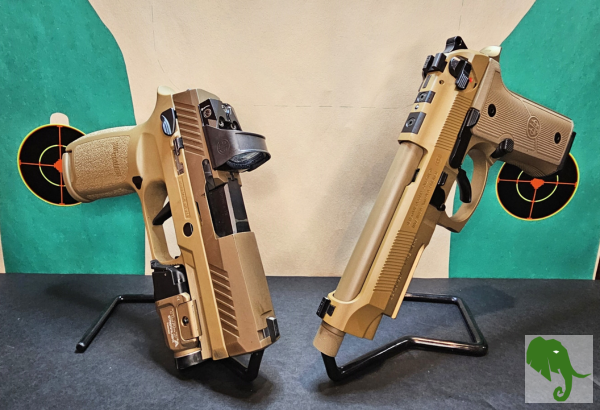
As a Marine veteran, I’ve trusted duty pistols like the Colt M1911A1, which I carried in Beirut in 1984 during its tenure as the Corps’ sidearm until 1985, and the Beretta M9, which I used in Division matches, trained with in the field, and came to value for its reliability and shootability during its service from 1985 to 2017. Those qualities now define two modern contenders: the Beretta M9A4, a modernized version of the M9, and the Sig Sauer P320-M17, the civilian counterpart of the Army’s M17 Modular Handgun System winner. Its sibling, the P320-M18, is now the standard sidearm of the Marine Corps, a nod to its versatility and performance.
Both of these full-size 9mm pistols are built with military, law enforcement, and defensive roles in mind. They feature optics-ready slides, high-capacity magazines, and durable construction. The real question is: which one is the better fit? Based on my experience with these pistols, I’ll compare the two handguns across dimensions, ergonomics, capacity, and other defining differences to help guide your decision. Whether you’re just looking for a range gun or a proven defensive tool, you can’t go wrong with either of these two modern-day pistols. If you’re deciding between the Beretta M9A4 vs P320 M17, this side-by-side review will help you choose the right platform for your needs.
A quick note: the featured image for this blog shows the P320-M18, not the M17. While the M18 is the model I personally own—chosen, of course, in honor of. In contrast, the Marine Corps—I’ve kept this comparison focused on the full-size M9A4 and M17 platforms.
Dimensions and Weight
When comparing the Beretta m9a4 vs p320 m17, size and frame material play a big role in overall feel and duty practicality.
The physical size and weight of a duty pistol affect how comfortably it carries,. However, how stable it is when fired, and whether it fits into your intended role. The Beretta M9A4 features a 5.1-inch threaded barrel, an overall length of 8.7 inches, a height of 5.4 inches, and a width of 1.5 inches. Unloaded, it weighs in at 33.4 ounces. Its all-metal aluminum frame contributes significantly to that heft. The threaded barrel also extends its length slightly, making it suppressor-ready out of the box.
This pistol is clearly designed for duty holsters or home defense setups and may feel too bulky for everyday concealed carry. In contrast, the Sig Sauer. As a result, P320-M17 has a 4.7-inch non-threaded barrel, is 8 inches in overall length, stands slightly taller at 5.5 inches, and measures a slimmer 1.4 inches in width. It weighs just 29.6 ounces unloaded, thanks to its polymer frame, which shaves off nearly 4 ounces compared to the M9A4.
This reduction in weight makes it more comfortable for extended carry. However, it lacks a threaded barrel by default, so anyone wanting suppressor compatibility will need aftermarket parts. Overall, the M9A4 is longer and. For example, heavier due to its metal construction and suppressor-ready design, giving it greater stability when shooting but making it less comfortable for all-day carry. The P320-M17’s polymer frame and shorter barrel give it the edge in comfort and manageability, though it sacrifices a bit of stability during rapid fire. Both are full-size pistols and not ideal for concealment, aligning more closely with traditional duty use.
| Description | Beretta M9A4 | Sig Sauer P320 M17 |
| Barrel | 5.1 in | 4.7 in |
| Length | 8.7 in | 8.0 in |
| Height | 5.4 in | 5.5 in |
| Width | 1.5 in | 1.4 in |
| Weight | 33.04 0z | 29.6 0z |
Ergonomics
In terms of ergonomics and shooter comfort, the Beretta m9a4 vs p320 m17 debate often centers on grip design and frame material.
How a pistol feels in your hand, how naturally it points, and how easy it is to operate all fall under ergonomics. Both the M9A4 and M17 are built with duty-grade ergonomics in mind, but they take different paths to get there.
The M9A4 comes with Vertec-style thin polymer grips that provide a more natural fit across a wide range of hand sizes. These grips are textured for control and can be swapped out with other panels, similar to what you’d see on a 1911. It features an oversized magazine release and a slide-mounted decocker in the G model configuration, which is decocker-only. The placement of this decocker might feel unfamiliar to those used to frame-mounted controls. A 3-slot Picatinny rail allows for attaching lights or lasers, enhancing its tactical versatility. The magwell is beveled to promote quicker reloads, which is particularly helpful in high-stress scenarios. The metal frame and aggressive grip texture give it excellent control under recoil, though its weight can be fatiguing during long shooting sessions.
A Different Approach
The P320-M17 takes a different approach with its modular polymer grip system. It’s available in various sizes: small, medium, and large, offering a customizable fit for any shooter. While its texture is less aggressive than the M9A4’s, it still provides secure handling under most conditions. The M17 includes ambidextrous slide catches and a reversible magazine release, making it highly adaptable for both left- and right-handed users. Its accessory rail supports tactical lights and lasers, and while it doesn’t have a flared magwell, it does include. Meanwhile, a cut at the bottom of the grip module that aids in manual magazine removal during malfunctions or administrative reloads. One standout feature is the serialized fire control unit, which allows easy swaps between grip modules, slides, and even calibers. The grip may feel less secure in wet or gloved conditions, but the modularity and ambidextrous features give it a strong edge.
In summary, the M9A4 offers a secure, premium feel with its Vertec grips. However, and metal frame, but it’s heavier and features a less intuitive slide-mounted decocker. The P320-M17’s lighter, modular grip system and ambidextrous controls make it more versatile and user-friendly.
Capacity
The Beretta m9a4 vs p320 m17 comparison also reveals differences in included magazines, out-of-the-box capacity, and long-term flexibility.
Magazine capacity is crucial in duty applications, where every round can matter. The Beretta M9A4 ships with three 18-round Mec-Gar magazines that are sand-resistant and PVD-coated for durability in harsh conditions. This gives it an 18+1 round capacity out of the box. For those in restrictive states, 10- or 15-round magazines are available. Its high capacity and inclusion of three magazines provide immediate value and tactical readiness.
Meanwhile, The Sig Sauer P320-M17 offers a 17+1 standard capacity and comes with two 17-round magazines. While slightly lower in capacity than the M9A4, it supports 21-round extended magazines for those who need more firepower. Like the M9A4, it also offers 10-round options for compliance. Although it includes fewer magazines and has a slightly lower standard capacity, the extended magazine flexibility offers a level of adaptability. Between the two,. In contrast, the M9A4 holds a slight edge in out-of-the-box capacity and reliability with sand-resistant magazines, while the M17 offers greater magazine options for customization and expansion.
Pros and Cons
Ultimately, the Beretta m9a4 vs p320 m17 matchup highlights the classic-vs-modern divide—durability and tradition versus modularity and ease of use.
Each pistol brings its own strengths and trade-offs. The Beretta M9A4 stands out with a threaded barrel for suppressor use, high. In contrast, 18+1 capacity, proven battlefield reliability, and a durable all-metal construction with FDE Cerakote finish. It features Vertec grips and a short-reset Xtreme Trigger System for improved shootability. On the downside, its 33.4-ounce weight makes it less ideal for long-term carry, and the DA/SA trigger system requires additional training to master. The slide-mounted decocker may not appeal to everyone, and the optics plate can interfere with co-witnessing. It also comes with a higher price tag, ranging from $850 to $900. The Sig Sauer MSRP starts around $1229. As a result, P320-M17, on the other hand, is notably lighter at 29.6 ounces, making it easier to carry. Its modular fire control unit allows for swapping frames, slides, and calibers, and.
However, the striker-fired trigger offers a consistent 5.5–6 pound pull that’s easy to learn. Its ambidextrous controls make it accessible to all shooters, and it is more affordable, typically priced between $650 and $750. However, its non-threaded barrel limits suppressor compatibility without aftermarket upgrades, and the polymer frame may not hold up as well under extreme abuse. Its grip texture is also less secure in wet conditions, and early production models had some reliability concerns, most of which have since. That said, been addressed. Ultimately, the M9A4 excels in features like suppressor readiness, capacity, and overall ruggedness, while the P320-M17 wins on modularity, accessibility, and affordability.
Key Differences
When comparing these two pistols, there are several technical distinctions worth noting. In terms of action, the M9A4 features a double-action/single-action system with a heavier 10–12 pound double-action pull and a lighter 4.5–5 pound single-action. Its decocker-only (G model) design is ideal for combat use but requires training to transition smoothly between trigger stages. The P320-M17 uses a striker-fired system with a consistent 5.5–6 pound trigger pull, making it easier for most shooters to learn and use. That said, under stress. Regarding build, the M9A4 is constructed from aluminum and steel with a durable FDE Cerakote finish, giving it a heavy-duty, field-ready feel. The M17 has a polymer frame with a stainless steel slide and a Coyote PVD finish, reducing its weight but slightly. Meanwhile, compromising impact resistance.
Suppressor Ready
Tactically, the M9A4 comes suppressor-ready with a threaded barrel and includes sand-resistant magazines, making it ideal for rugged environments. The M17 emphasizes modularity with its FCU, allowing for caliber and grip module swaps, but lacks suppressor support in its. As a result, standard form. When it comes to sights, the M9A4 uses dovetailed tritium night sights and is optics-ready with optional plates. However, its plate height may limit co-witnessing. The M17 includes SIGLITE night sights and an optics-ready slide designed for full co-witnessing with most red dots.. In contrast, Aftermarket support is strong for both, but the M17’s modularity and FCU design give it the edge in versatility. The M9A4 benefits from legacy support in the M9/92 series but is less flexible.
Finally, there’s the price-to-value ratio. The M9A4 runs a bit higher, but it comes with three 18-round magazines, robust construction,. That said, and a few extras that justify the cost—especially if you’re someone who values ruggedness and reliability. One thing that stands out right away is the packaging. Instead of the usual plastic pistol case, the M9A4 ships in a flat dark earth military-style ammo can. It’s foam-lined and functional, and while not exactly discreet, it’s a nice nod to the pistol’s military lineage. It gives the unboxing a bit more presence and utility—something that feels more field-ready than commercial.
Final Thoughts
Whether you value modularity or old-school toughness, the Beretta m9a4 vs p320 m17 decision comes down to your mission, environment, and personal style.
The Beretta M9A4 and Sig Sauer P320-M17 are both excellent duty pistols with military lineage and features that suit a wide range of defensive and professional roles. The M9A4 stands out for its suppressor-ready threaded barrel, higher capacity, and all-metal construction, appealing to those who appreciate durability, traditional design, and battlefield reliability. It’s heavier and more expensive, but the included magazines and enhanced features may justify the cost for serious users.
For example, In contrast, the P320-M17 is lighter, more modular, and more affordable, with a user-friendly striker-fired system and ambidextrous design.
M17 Adaptable
The fire control unit of the P320-M17 makes it one of the most adaptable pistols on the market. It may lack suppressor readiness and some of the ruggedness of the M9A4, but its flexibility and ease of use make it ideal.
Meanwhile, for new shooters, duty carry, or those seeking one platform with multiple configuration options. Ultimately, your choice depends on your intended use and preferences. If you value tradition, durability, and a robust, battle-tested design, the M9A4 is a strong contender. If you want modern simplicity, modularity, and a lighter carry package, the P320-M17 may be your best bet. Either way, you’ll have a pistol backed by military trust and engineered for real-world performance.
Related Content
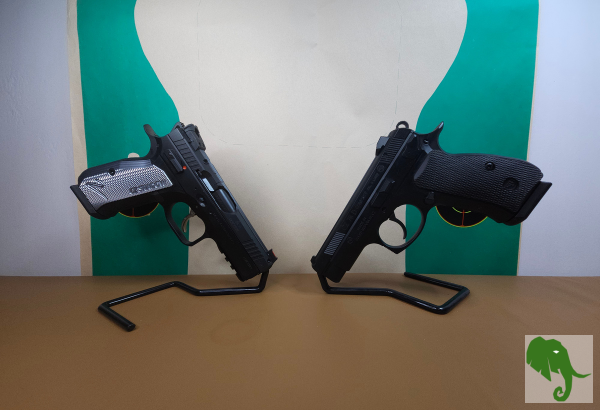
CZ Shadow 2 Compact and 75D PCR Compact
During one of my many visits to the local firearms store, I picked up the CZ Shadow 2 Blue in a spontaneous purchase. I was…
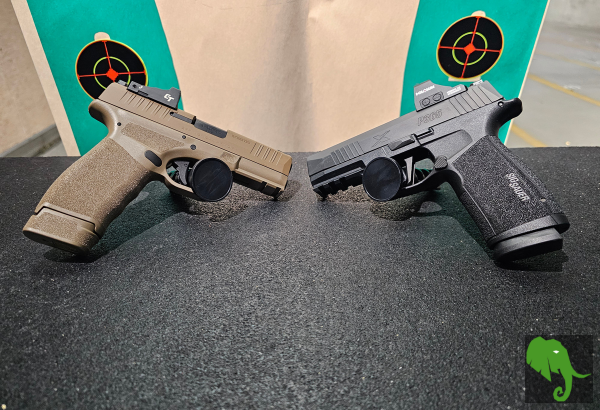
Sig Sauer P365 XMacro and Springfield Hellcat Pro Comparison
This summer, I decided to switch to a micro-compact pistol for my everyday carry (EDC). This was a change from the compact EDC I typically…

Springfield DS Prodigy 4.25 and Bul Armory SAS II TAC 5
Not too long ago, I got the itch to own a premium pistol, particularly a 2011-style firearm. I considered several well-respected manufacturers like …
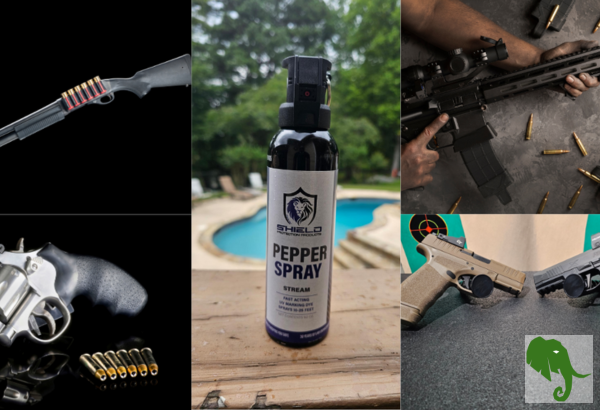
Deciding On a Home Defense Tool
A few weeks ago, I was visiting our local firearms shop and overheard a customer discussing with one of the staff choices for a…

Read other OwnGuard Solutions blog posts
Read our other posts centered around being safer and better prepared.

